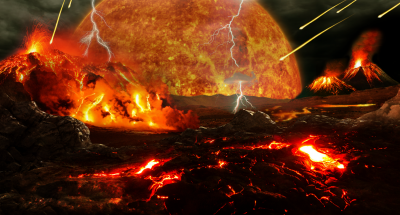
|
Earth’s surface was probably molten for many millions of years after its formation. Life did not exist for the first 400-800 million years, and first began in water after the forming of the oceans. |
Life seems to have started on Earth almost as soon as the surface cooled off enough to make it possible. However, complex animal life—everything from insects to fish to humans – took a lot longer to show up. Given that modern animals are a phenomenally diverse group that evolved relatively quickly, why were they so slow to get going?
The answer may be that animals are greedy: they need a lot of oxygen to grow big and complicated. Early Earth didn’t have much oxygen, but microbes changed the chemical content of the atmosphere over time from something alien and poisonous to us into the breathable air we have today. A new paper showed that the oxygen level as recently as 800 million years ago was only a tiny fraction of today’s – far too low to support oxygen-breathers like our ancestors and their relatives.
Life on Earth has always belonged mainly to microorganisms. Clouds are full of microbes; they have been found in deep mines and on the ocean floor. They outnumber and may even outweigh all other forms of life. If all animals vanished, most bacteria would still live on, but if all bacteria disappeared, we would die quickly.
The history of life on Earth reflects this as well. The first single-celled organisms appeared about 3.8 billion years ago, while the first known multi-cellular organisms evolved 2.1 billion years ago. However, these were “primitive” in our human-centric eyes: they didn’t have specialized organs for breathing or eating, much less brains for the wasteful activity we call “thinking”.
Then in the Cambrian era, around 570 million years ago, recognizably complex animal life evolved, including vertebrate ancestors. This change was relatively rapid in evolutionary terms, and a lot of diverse critters came out of it. Thus, something significant must have changed between 2.1 billion years and 570 million years to let animals diversify and complexity.
To explain this great change, scientists consider several possible explanations. One environmental (as opposed to genetic) idea: animals breathe in oxygen, so there needs to be enough oxygen in the air and water. Corals, sponges, and the like require less oxygen than crabs or fish, so oxygen levels limit what sorts of animals can evolve in a particular environment.
Credit: Daily Beast
Picture credit: Google




